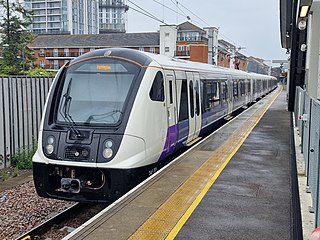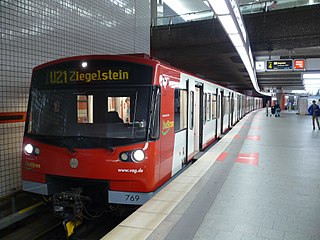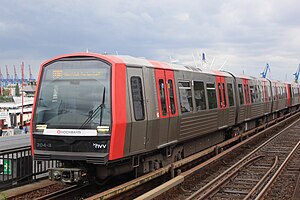
The Hamburg U-Bahn is a rapid transit system serving the cities of Hamburg, Norderstedt, and Ahrensburg in Germany. Although referred to by the term U-Bahn, most of the system's track length is above ground. The network is interconnected with the city's S-Bahn system, which also has underground sections. It is operated by Hamburger Hochbahn within the Hamburger Verkehrsverbund (HVV). It was opened in February 1912, and comprises four lines serving 93 stations, with a route length of 106.4 kilometres (66.1 mi) in 2019.

The Talent is a multiple unit railcar manufactured by Bombardier that was developed by Waggonfabrik Talbot in Aachen shortly before the company was acquired by Bombardier in 1995. The name Talent is an acronym in German for TALbot LEichter Nahverkehrs-Triebwagen.
Bombardier Transportation was a Canadian-German rolling stock and rail transport manufacturer, with headquarters in Berlin, Germany. It was one of the world's largest companies in the rail vehicle and equipment manufacturing and servicing industry. Bombardier Transportation had many regional offices, production and development facilities worldwide. It produced a wide range of products including passenger rail vehicles, locomotives, bogies, propulsion and controls. In February 2020, the company had 36,000 employees, and 63 manufacturing and engineering locations around the world. Formerly a division of Bombardier Inc., the company was acquired by French manufacturer Alstom on 29 January 2021.

CRRC Changchun Railway Vehicles Co., Ltd. is a Chinese rolling stock manufacturer and a division of the CRRC. While the CRV emerged in 2002, the company's roots date back to the establishment of the Changchun Car Company in 1954. The company became a division of CNR Corporation before its merger with CSR to form the present CRRC. It has produced a variety of rolling stock for customers in China and abroad, including locomotives, passenger cars, multiple units, rapid transit and light rail vehicles. It has established technology transfer partnerships with several foreign railcar manufacturers, including Bombardier Transportation, Alstom, and Siemens Mobility.

The Double-deck Coach is a bilevel passenger railcar currently manufactured by Alstom, which acquired Bombardier Transportation in 2021 used by various European railways and Israel Railways. The current generation of double-deck coaches can be run at speeds up to 200 km/h (125 mph). Depending on their configuration, each coach can seat 100 to 150 passengers.

The Alstom Movia is a family of metro train cars designed by Adtranz and later built by Bombardier Transportation and Alstom. The structure and body shell are fully customisable for the needs of each system that orders it. Unlike most traditional metro trains, they usually have full-width gangways between carriages, allowing passengers to walk the entire length of the train. The design was developed by Adtranz, which was acquired by Bombardier in 2001. Since Alstom's acquisition of Bombardier in 2021, Alstom will be responsible for construction and delivery of future Movia metro train cars.

The Siemens Modular Metro is a family of electric multiple unit trains for rapid transit systems produced by Siemens Mobility and used by rail operators around the world. The vehicle concept was launched in Vienna in 2000 and is a modular concept allowing many variants of metro vehicles. Previously known as Modular Mobility, Siemens, whose rail equipment division had since been renamed Siemens Mobility, still uses the abbreviation Mo.Mo; however, few of these trains are being built, since Siemens had moved to their Inspiro metro platform in 2013.

The Type DT4 is a four-car electric multiple unit (EMU) train type operated by the Hamburger Hochbahn AG on the Hamburg U-Bahn system since 1988.

A gangway connection is a flexible connector fitted to the end of a railway coach, enabling passengers to move between coaches without danger of falling from the train.

The Alstom Aventra is a family of electric multiple unit (EMU) passenger trains produced at Derby Litchurch Lane Works in the United Kingdom, originally by Bombardier Transportation and later by Alstom, as a successor to the Bombardier Electrostar. A large proportion of its design is based on the Electrostar, adding new technologies and achieving compliance with more stringent requirements and operator demands.

The MPM-10, commonly known as the Azur, is the third and newest generation of rubber-tired rolling stock used on the Montreal Metro in Canada, built by a consortium of Bombardier Transportation and Alstom. The first MPM-10 train entered into service on the Orange Line in February 2016, replacing the entire first-generation MR-63 fleet. 71 nine-car trains have been built, and are currently in service on the Orange and Green Lines.

ICE 4 is a brand name for long-distance Intercity-Express high-speed trains being procured for Deutsche Bahn.

The Type DT3 is a three-car electric multiple unit (EMU) train type operated by the Hamburger Hochbahn AG on the Hamburg U-Bahn.They were first introduced in 1968 to replace the 1911 to 1929-built Type T cars and to speed up the journey times on line U1.

The Type DT2 is a two-car electric multiple unit (EMU) train type operated by the Hamburger Hochbahn AG on the Hamburg U-Bahn until 2015. They replaced the Type T and Type TU.

The Type DT1 is a two-car electric multiple unit (EMU) train type operated by the Hamburger Hochbahn AG on the Hamburg U-Bahn until 1991. They were the first new U-Bahn trains since the 1920s.

The Type A is an electric multiple unit (EMU) train type formerly operated on the Hamburg U-Bahn system. They were the first type of subway cars in Hamburg, entering service on 15 February 1912, and were later designated as Type T. Some cars were converted to maintenance service cars.

The SL C20 is a type of subway train used in the Stockholm metro, Sweden. Between 1997 and 2004, 271 3-car sets, numbered 2000–2270, were delivered to Stockholm by the former Kalmar Verkstad, owned by Adtranz, later acquired by Bombardier Transportation. The C20 is a completely new design and therefore is not compatible with other train types in the system. At 46.5 metres, each carriage is longer than the previous train types. To save cost and weight, each unit has only four bogies. The middle car has two bogies. The end parts consist of one bogie each and are connected to the central portion via a semi-trailer-direction. Trolley subframes are made of stainless steel, and are less susceptible to corrosion.

The MVG Class C is an electric multiple unit (EMU) train type operated by the Münchner Verkehrsgesellschaft on the Munich U-Bahn system since 2002. It is the first type of rolling stock on the Munich U-Bahn that consists of more than two cars and features gangways between the individual cars.

The VAG Class DT3 is an electric multiple unit (EMU) train type operated by the Verkehrs-Aktiengesellschaft Nürnberg on the Nuremberg U-Bahn system. It is the first type of rolling stock on the Nuremberg U-Bahn that has gangways between the individual cars.

The VAG Class G1 is an electric multiple unit (EMU) train type operated by the Verkehrs-Aktiengesellschaft Nürnberg on the Nuremberg U-Bahn system. They have replaced the VAG Class DT1 and VAG Class DT2 previously in service on Nuremberg U-Bahn line U1. On 20 August 2020, the first of three G1 trains entered into the revenue service.





















